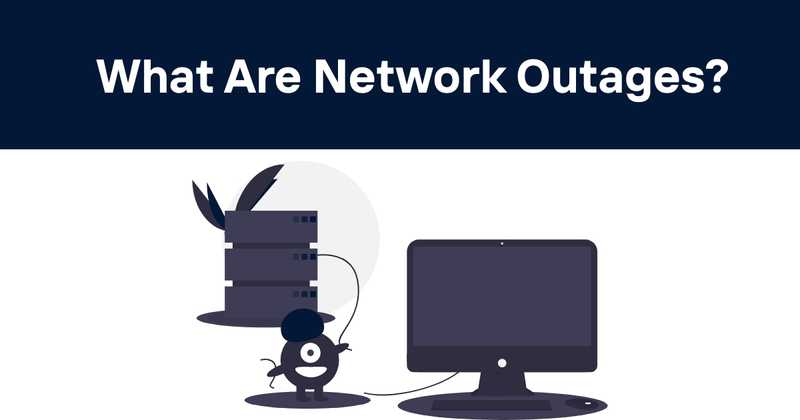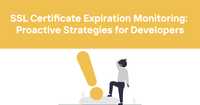Network Outages Explained: Causes, Impacts, and Prevention Strategies
Network outages can strike at any moment, disrupting critical business operations and frustrating users. For software developers and IT professionals, understanding the intricacies of network outages is crucial for maintaining robust systems and minimizing downtime. This article delves into the world of network outages, exploring their causes, far-reaching impacts, and essential prevention strategies.
Table of Contents
- What is a Network Outage?
- Types of Network Outages
- Common Causes of Network Outages
- The Impact of Network Outages
- Detecting and Diagnosing Network Outages
- Prevention Strategies
- Responding to Network Outages
- The Role of Monitoring in Outage Prevention
- Future Trends in Network Resilience
- Conclusion
What is a Network Outage?
A network outage occurs when a portion of a network infrastructure becomes unavailable, preventing normal communication between devices or systems. This disruption can range from a localized issue affecting a single device to a widespread failure impacting entire regions or global services.
Network outages can manifest in various ways:
- Complete loss of connectivity
- Intermittent connection issues
- Significant performance degradation
- Inability to access specific services or resources
For developers, network outages present unique challenges, as they can affect both the development process and the end-user experience of the applications they create.
Types of Network Outages
Understanding the different types of network outages is essential for effective troubleshooting and prevention. Here are the primary categories:
1. Total Outages
A total outage results in a complete loss of network connectivity. During a total outage:
- No data can be transmitted or received
- All network-dependent services become inaccessible
- The impact is usually immediate and severe
2. Partial Outages
Partial outages affect only a portion of the network or specific services. Characteristics include:
- Some systems or services remain operational
- The impact may be limited to certain user groups or geographic areas
- Can be more challenging to detect and diagnose than total outages
3. Intermittent Outages
These outages are characterized by fluctuating connectivity. Key features:
- Network availability alternates between functional and non-functional states
- May occur at regular intervals or unpredictably
- Can be particularly frustrating for users and difficult to troubleshoot
4. Performance-Related Outages
While not a complete loss of connectivity, severe performance degradation can effectively render a network unusable:
- Extremely high latency
- Significant packet loss
- Dramatically reduced bandwidth
5. Application-Specific Outages
These outages affect particular applications or services while leaving others intact:
- May be caused by issues with the application itself or its supporting infrastructure
- Can be mistaken for network-wide problems
Understanding these distinctions helps in accurately identifying and addressing the root cause of an outage.
Common Causes of Network Outages
Network outages can stem from a variety of sources, ranging from physical infrastructure failures to cyber attacks. Here are some of the most common causes:
Hardware Failures
Physical components of the network infrastructure can fail due to:
- Age and wear
- Manufacturing defects
- Environmental factors (heat, humidity, power surges)
Key hardware components susceptible to failure include:
- Routers
- Switches
- Servers
- Fiber optic cables
Software Issues
Software-related problems can lead to outages through:
- Bugs in network management software
- Misconfigurations
- Incompatible software updates
- Operating system crashes
Human Error
Despite advances in automation, human error remains a significant cause of network outages:
- Misconfigurations during routine maintenance
- Accidental cable disconnections
- Improper change management procedures
Cyber Attacks
Malicious activities can cause or exacerbate network outages:
- Distributed Denial of Service (DDoS) attacks
- Malware infections
- Ransomware attacks
Natural Disasters
Environmental events can severely impact network infrastructure:
- Earthquakes
- Floods
- Hurricanes
- Severe storms
Power Failures
Loss of power can immediately bring down network components:
- Grid failures
- Local power outages
- Uninterruptible Power Supply (UPS) failures
Capacity Overloads
Networks can fail when demand exceeds capacity:
- Sudden traffic spikes
- Inadequate bandwidth allocation
- Poor capacity planning
Third-Party Provider Issues
Many organizations rely on external service providers, introducing additional points of failure:
- ISP outages
- Cloud service provider downtime
- Content Delivery Network (CDN) failures
Understanding these causes is crucial for developing comprehensive prevention and mitigation strategies.
The Impact of Network Outages
The consequences of network outages extend far beyond mere inconvenience, affecting businesses, individuals, and even entire economies. Let's explore the multifaceted impact of these disruptions:
Financial Losses
Network outages can lead to significant financial repercussions:
- Lost revenue due to downtime
- Decreased productivity
- Costs associated with recovery and mitigation
- Potential contractual penalties for failing to meet service level agreements (SLAs)
A study by Gartner estimated that the average cost of network downtime is around $5,600 per minute, highlighting the substantial financial risk.
Reputation Damage
Outages can severely harm an organization's reputation:
- Loss of customer trust
- Negative media coverage
- Reduced competitiveness in the market
In the age of social media, news of outages spreads quickly, potentially causing long-lasting damage to a company's image.
Data Loss and Security Risks
Network outages can compromise data integrity and security:
- Incomplete transactions leading to data inconsistencies
- Increased vulnerability to cyber attacks during recovery
- Potential loss of unsaved work or in-transit data
Operational Disruptions
Businesses heavily reliant on network connectivity face severe operational challenges:
- Halted production lines
- Interrupted supply chains
- Inability to process transactions or serve customers
Regulatory and Compliance Issues
Certain industries may face regulatory consequences due to outages:
- Violations of uptime requirements in regulated sectors
- Failure to meet data protection standards
- Potential legal liabilities
Employee Productivity and Morale
Frequent or prolonged outages can affect the workforce:
- Frustration and stress among employees
- Reduced efficiency and productivity
- Potential for errors during recovery processes
Customer Experience
End-users bear the brunt of network outages:
- Inability to access essential services
- Frustration with unreliable systems
- Potential switch to competitors offering more reliable services
Broader Economic Impact
Large-scale outages can have far-reaching economic consequences:
- Disruption of financial markets
- Interruption of critical infrastructure services
- Cascading effects on interconnected businesses and industries
Understanding these impacts underscores the critical importance of robust network infrastructure and effective outage prevention strategies.
Detecting and Diagnosing Network Outages
Swift detection and accurate diagnosis of network outages are crucial for minimizing their impact. Here's an overview of effective approaches:
Monitoring Tools
Implement comprehensive monitoring solutions:
- Network performance monitors (NPMs)
- Application performance monitors (APMs)
- Infrastructure monitoring tools
These tools provide real-time insights into network health and can alert administrators to potential issues before they escalate into full-blown outages.
Automated Alerts
Set up automated alerting systems to notify relevant personnel immediately when issues arise:
- Email notifications
- SMS alerts
- Integration with ticketing systems
Ensure that alerts are properly prioritized to avoid alert fatigue.
User Reports
While not the ideal first line of defense, user reports can be valuable:
- Implement easy-to-use reporting systems for end-users
- Train support staff to quickly escalate potential network issues
Log Analysis
Regularly analyze network logs to identify patterns and potential issues:
- Use log aggregation tools for centralized analysis
- Look for recurring errors or unusual activity patterns
Network Topology Mapping
Maintain up-to-date network topology maps:
- Visualize the network structure
- Quickly identify affected areas during an outage
Diagnostic Tools
Utilize diagnostic tools for troubleshooting:
- Ping and traceroute for basic connectivity tests
- Packet analyzers like Wireshark for detailed traffic inspection
- Command-line tools like netstat for port and connection analysis
Synthetic Monitoring
Implement synthetic monitoring to proactively test network performance:
- Simulate user interactions with critical applications
- Regularly test connectivity from various geographic locations
Root Cause Analysis
Once an outage is detected, conduct thorough root cause analysis:
- Use the "5 Whys" technique to dig deeper into the underlying causes
- Document findings to prevent similar issues in the future
Correlation Analysis
Look for correlations between different events or metrics:
- Analyze the relationship between network traffic patterns and outages
- Identify any environmental factors coinciding with network issues
Third-Party Service Status
For outages potentially caused by external providers:
- Check provider status pages
- Set up alerts for announcements from critical service providers
By combining these detection and diagnostic methods, organizations can significantly improve their ability to identify, understand, and resolve network outages quickly and effectively.
Prevention Strategies
Proactive measures are key to minimizing the risk and impact of network outages. Here are essential prevention strategies:
Redundancy and Failover Systems
Implement redundant network components and failover mechanisms:
- Duplicate critical hardware (routers, switches, servers)
- Set up backup power supplies and generators
- Use multiple internet service providers (ISPs)
- Implement load balancers to distribute traffic
Regular Maintenance and Updates
Maintain network infrastructure proactively:
- Schedule regular hardware inspections and replacements
- Keep software and firmware up to date
- Apply security patches promptly
Capacity Planning
Ensure your network can handle current and future demands:
- Regularly assess bandwidth requirements
- Plan for traffic spikes during peak periods
- Implement scalable infrastructure solutions
Network Segmentation
Divide the network into smaller, manageable segments:
- Isolate critical systems from general network traffic
- Implement VLANs to improve security and performance
- Use subnetting to optimize network resources
Disaster Recovery Planning
Develop and maintain comprehensive disaster recovery plans:
- Create detailed procedures for various outage scenarios
- Regularly test and update recovery plans
- Train staff on disaster recovery procedures
Change Management Processes
Implement strict change management protocols:
- Thoroughly test changes in a staging environment before deployment
- Schedule maintenance during low-traffic periods
- Have rollback plans for all significant changes
Security Measures
Protect against outages caused by malicious activities:
- Implement robust firewalls and intrusion detection systems
- Regularly conduct security audits and penetration testing
- Educate employees about cybersecurity best practices
Quality of Service (QoS) Implementation
Prioritize critical network traffic:
- Configure QoS settings on network devices
- Ensure essential services receive adequate bandwidth
Documentation and Knowledge Management
Maintain detailed documentation of the network infrastructure:
- Keep network diagrams and configurations up to date
- Document troubleshooting procedures and lessons learned
Automated Configuration Management
Use automation tools to manage network configurations:
- Implement configuration management systems
- Automate routine tasks to reduce human error
Service Level Agreements (SLAs)
Establish clear SLAs with vendors and service providers:
- Define acceptable uptime and performance metrics
- Include penalties for failing to meet agreed-upon standards
Environmental Controls
Protect physical infrastructure from environmental hazards:
- Implement proper cooling and humidity control in server rooms
- Use raised floors and proper cable management to prevent physical damage
Traffic Analysis and Optimization
Regularly analyze network traffic patterns:
- Use traffic shaping and prioritization techniques
- Optimize routing for improved performance
Employee Training
Invest in ongoing training for IT staff:
- Keep team members updated on the latest networking technologies
- Conduct regular drills for outage response
By implementing these prevention strategies, organizations can significantly reduce the likelihood of network outages and minimize their impact when they do occur.
Responding to Network Outages
When a network outage occurs, a swift and organized response is crucial to minimize downtime and mitigate its impact. Here's a structured approach to responding to network outages:
1. Immediate Response
- Activate the incident response team
- Assess the scope and severity of the outage
- Implement temporary workarounds if possible
2. Communication
- Notify affected users and stakeholders
- Provide regular updates on the situation
- Use multiple communication channels (email, SMS, status page)
3. Diagnosis
- Gather data from monitoring tools and logs
- Conduct initial troubleshooting to identify the cause
- Prioritize critical systems for recovery
4. Containment
- Isolate affected systems to prevent further spread
- Implement emergency security measures if necessary
- Redirect traffic to functioning systems or backup sites
5. Recovery
- Execute the appropriate recovery plan based on the outage type
- Restore systems and data from backups if required
- Conduct thorough testing before declaring systems operational
6. Verification
- Confirm full functionality of all affected systems
- Verify data integrity and security
- Ensure all users have regained access
7. Post-Incident Analysis
- Conduct a detailed root cause analysis
- Document the incident and response process
- Identify areas for improvement in prevention and response
8. Lessons Learned
- Update disaster recovery and business continuity plans
- Implement new preventive measures based on findings
- Conduct additional training if necessary
9. Follow-up
- Monitor systems closely for any residual issues
- Address any lingering concerns from users or stakeholders
- Conduct a formal review of the incident response process
By following this structured approach, organizations can effectively manage network outages, minimize their impact, and improve their resilience against future incidents.
The Role of Monitoring in Outage Prevention
Effective monitoring plays a crucial role in preventing and mitigating network outages. Here's how comprehensive monitoring contributes to network resilience:
Early Warning System
- Detect anomalies before they escalate into full outages
- Identify performance degradation trends
- Alert administrators to potential issues in real-time
Proactive Maintenance
- Schedule maintenance based on performance data
- Identify hardware nearing end-of-life
- Optimize network configurations for better performance
Capacity Planning
- Analyze traffic patterns to predict future needs
- Identify bandwidth bottlenecks
- Plan for infrastructure upgrades based on usage trends
Root Cause Analysis
- Provide detailed logs and performance data for troubleshooting
- Help correlate events across different systems
- Facilitate faster resolution of complex issues
SLA Compliance
- Track uptime and performance metrics
- Generate reports for compliance and auditing purposes
- Validate service quality from third-party providers
Security Monitoring
- Detect unusual traffic patterns that may indicate security threats
- Monitor for unauthorized access attempts
- Identify potential vulnerabilities in the network
Performance Optimization
- Identify underperforming network segments
- Optimize traffic routing based on real-time data
- Fine-tune application performance
Historical Analysis
- Maintain long-term performance data for trend analysis
- Compare current performance against historical baselines
- Identify recurring issues or patterns
User Experience Monitoring
- Simulate end-user interactions to test critical services
- Monitor application response times from various locations
- Identify issues from the user's perspective
Integration with ITSM
- Automatically create tickets for detected issues
- Provide relevant data to support teams for faster resolution
- Track incident patterns for continual service improvement
Customized Alerting
- Set up intelligent alerting based on specific thresholds
- Reduce alert fatigue through correlation and prioritization
- Ensure the right personnel are notified for different types of issues
Visualization and Reporting
- Create dashboards for real-time network status overview
- Generate detailed reports for management and stakeholders
- Visualize complex network topologies for easier understanding
Implementing a robust monitoring strategy that encompasses these aspects can significantly enhance an organization's ability to prevent, detect, and respond to network outages effectively.
Future Trends in Network Resilience
As technology evolves, so do the strategies for ensuring network resilience. Here are some emerging trends that are shaping the future of network outage prevention and management:
AI and Machine Learning
- Predictive analytics for proactive issue detection
- Automated root cause analysis
- Self-healing networks that can reconfigure to avoid outages
Edge Computing
- Distributed processing to reduce reliance on central networks
- Improved local resilience and reduced latency
- Better handling of IoT device proliferation
Software-Defined Networking (SDN)
- Dynamic traffic routing for improved load balancing
- Faster network reconfiguration during outages
- Simplified management of complex network topologies
Network Function Virtualization (NFV)
- Reduced dependence on physical hardware
- Faster deployment of network services
- Improved scalability and flexibility
5G and Beyond
- Enhanced mobile network resilience
- Support for massive IoT deployments
- Ultra-low latency for critical applications
Zero Trust Security
- Improved security posture to prevent outages due to breaches
- Continuous authentication and authorization
- Micro-segmentation for containing potential issues
Quantum Networking
- Potentially unhackable communication channels
- Ultra-secure key distribution
- New paradigms for network resilience
Intent-Based Networking
- Networks that can automatically implement high-level business policies
- Continuous verification of network state against intended configuration
- Reduced human error in network management
Blockchain for Network Management
- Decentralized and tamper-proof network logs
- Smart contracts for automated SLA enforcement
- Improved traceability for regulatory compliance
Cloud-Native Network Functions
- Containerized network services for improved portability
- Microservices architecture for better fault isolation
- Easier scaling and updating of network functions
Augmented Reality for Network Visualization
- Improved troubleshooting through visual overlays
- Enhanced training for network technicians
- More intuitive management of complex network topologies
Autonomous Networks
- Self-optimizing networks that adapt to changing conditions
- AI-driven capacity planning and resource allocation
- Automated compliance and security policy enforcement
As these technologies mature and become more widely adopted, they promise to significantly enhance network resilience, reducing the frequency and impact of outages while improving overall performance and security.
Conclusion
Network outages remain a significant challenge in our increasingly connected world. For software developers and IT professionals, understanding the causes, impacts, and prevention strategies for network outages is crucial for building and maintaining robust, resilient systems.
By implementing comprehensive monitoring solutions, adopting proactive prevention strategies, and staying informed about emerging technologies, organizations can significantly reduce the risk and impact of network outages. As we move towards more autonomous and intelligent networks, the focus shifts from reactive troubleshooting to predictive maintenance and self-healing systems.
Remember, the key to minimizing network outages lies in a combination of technological solutions, well-defined processes, and skilled personnel. By continuously improving in these areas, we can build networks that are not only more reliable but also more capable of supporting the ever-growing demands of our digital world.
Stay vigilant, keep learning, and always be prepared to adapt to new challenges and opportunities in the realm of network resilience. The future of stable, high-performance networks depends on the collective efforts of professionals like you.



